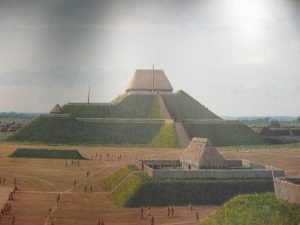In visiting the “Castine Mounds,” near the Cahokia creek, in Illinois, a writer says: “After a drive of an hour and a half the second group of eminences, known as the Castine Mounds, appeared upon the prairie at a distance of three or four miles; the celebrated Monk Hill, the largest monument of the kind yet discovered in North America, heaving up its giant form, forest clothed from in the midst; as it is first beheld, surrounded by the lesser heaps, it is mistaken by the traveler for an elevation of natural origin; as he draws nigh, and at length stands at the base, its stupendous magnitude, its lofty summit, towering above his head and throwing its broad shadow far across the meadow; its slopes plowed with yawning ravines by the torrents of centuries, descending to the plane ; its surface and declivities perforated by the habitations of burrowing animals, and carpeted with tangled thickets; the vast size of the aged oaks rearing themselves from its soil, all confirm his impression that no hand but that of the mightiest could have reared the enormous mass. At that moment, should he be assured that his vast earth-heap was of origin demonstrably artificial, he would smile, but credulity the most sanguine would fail to credit the assertion. But when, with jealous eye, slowly and cautiously, and with measured footsteps he has circled its base; when he has surveyed its slopes and declivities from every position, and has remarked the peculiar uniformity of its structure, and the mathematical exactitude of its outline; when he has ascended to its summit, and looked around upon the piles of a similar character by which it is surrounded; when he has taken into consideration its situation upon a river bottom of a nature decidedly diluvia, and, of consequence, utterly incompatible with the natural origin of such elevations; when he has examined the soil of which it is composed, and has discovered it to be uniformly, throughout the entire mass, of the same mellow and friable species as that of the prairies at its base; and. when he has listened with scrutiny to the facts which, on examination of its depths, has thrown to light of its nature and its contents, he is compelled, however reluctantly, yet without a doubt, to declare that the gigantic pile is incontestably the workman ship of man’s hand.” But when, by what race of mankind, and for what purpose? What changes they have undergone, what vicissitudes and resolutions, like massive waves, have rolled at their base during the centuries that have come and gone, who can conjecture? As the gloom and silent pyramids of Egypt, for ages unnumbered, have looked down upon generation after generation as they came and went, and whose existence remains a mystery, so too do the mounds of North America point our inquiry back beyond the grasp of human thought into the shades and mists of centuries past, and bid us seek their origin and history there. But their design was evidently for various purposes some as cemeteries, some as fortifications, some as watchtowers or vedettes, for religious ceremonies and memorials.

The largest of the Castine group of about fifty is Monk Mound, whose base is said to be nearly six hundred yards in circumference and in height nearly a hundred feet. Its form is that of a rectangle, lying north and south; and upon the latter extremity, which commands the view down the bottom, is spread out a broad terrace, or rather a steppe to the main body, about twenty feet lower than the summit, extending the whole length of the side and is said to be one hundred and fifty feet in breadth. At the left extremity of this terrace winds up the sloping pathway from the prairie to the summit of the mound. A well, it is also stated, has been sunk on the western side of the mound (Mound Monk) to the depth of ninety feet, which penetrates the heart of the mound, but cannot reach, from its depth, lower than the level of the surrounding- plain. And it is stated, when it was excavated, fragments of pottery, decayed ears of corn and various other articles were brought up from a depth of sixty five feet; surely a conclusive proof, if true, that it is of artificial structure. The mound is supposed to have taken its name from a society of ecclesiastics of the La Trappe order who dwelt there for many years in the early part of the pre sent century.
